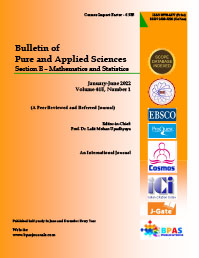Neutrosophic Statistics is an extension of Interval Statistics, while Plithogenic Statistics is the most general form of statistics (Third version)
DOI:
https://doi.org/10.48165/Keywords:
Neutrosophic Statistics, Plithogenic StatisticsAbstract
In this paper we prove that Neutrosophic Statistics is an extension of the Interval Statistics, since it may deal with all types of indeterminacies (with respect to the data, inferential procedures, probability distributions, graphical representations, etc.), it allows the reduction of indeterminacy, and it uses the neutrosophic probability that is more general than imprecise and classical probabilities, andhas more detailed corresponding probability density functions. While Interval Statistics only deals with indeterminacy that can be represented by intervals. And we respond to the arguments by Woodall et al. [1]. We show that not all indeterminacies (uncertainties) may be represented by intervals. Also, in some applications, we should better use hesitant sets (that have less indeterminacy) instead of intervals. We redirect the authors to the Plithogenic Probability and Plithogenic Statistics that are the most general forms of MultiVariate Probability and MultiVariate Statistics respectively (including, of course, the Imprecise Probability and Interval Statistics as subclasses).
References
William H. Woodall, Anne R. Driscolli, and Douglas C. Montgomery (2022). A Review and Perspective on Neutrosophic Statistical Process Monitoring Methods, preprint, ResearchGate.
Florentin Smarandache (2014). Introduction to Neutrosophic Statistics, Sitech & Education Publishing, Craiova, 2014, 124 p. http://fs.unm.edu/NeutrosophicStatistics.pdf .
The website of Neutrosophic Statistics where you're cited as well: http://fs.unm.edu/NeutrosophicStatistics.htm
H. Zhang, J. Wang, and X. Chen (2014). Interval neutrosophic sets andtheir application in multicriteria decision making problems, Scientific World Journal Volume 2014, Article ID 645953, 15 pages, http://dx.doi.org/10.1155/2014/645953.
F. Smarandache (2013). Introduction to Neutrosophic Measure, Neutrosophic Integral, and Neutrosophic Probability, Sitech Publishing House, Craiova, http://fs.unm.edu/NeutrosophicMeasureIntegralProbability.pdf
F. Smarandache (2016). Nidus idearum. Scilogs, II: de rerum consectatione (second edition) Brussels, pages 109-110, http://fs.unm.edu/NidusIdearum2-ed2.pdf
F. Smarandache (2021). Plithogenic Probability & Statistics are generalizations of MultiVariate Probability & Statistics, Neutrosophic Sets and Systems, 43, 280-289.
Frederica Gioia, Carlo N. Lauro (2005). Basic Statistical Methods for Interval Data, Statistica Applicata, 17(1), 1-29.
